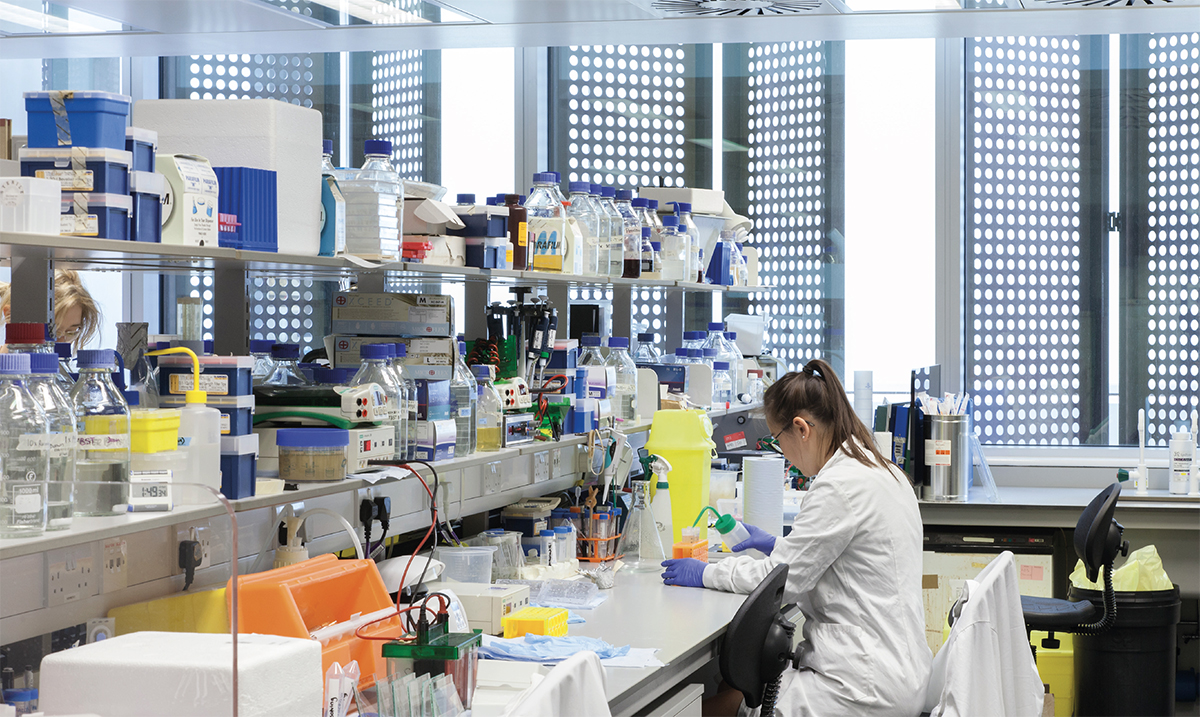What are life sciences?
Life science research is interested in the application of biology and technology for health improvement, including biopharmaceuticals, medical technology, advanced therapies, genomics, neuroscience, diagnostics and digital health and generates a wide range of products including drugs, medical technology, diagnostics and digital tools, as well as products for consumer health.
The life sciences industry represents one of the dominant economic sectors in the UK. Even before the Covid-19 pandemic, life sciences has been an expanding sector and is now seen as one of the most resilient.
Recent Government research has found that the UK life sciences sector has (as of March 2020), contributed £74 billion to the UK economy and it is committed to transforming the UK into a ‘life sciences superpower’.
A life sciences community brings together clinicians, scientists, researchers, data modellers and entrepreneurs, in one place, to collaborate and innovate. However, while life sciences led the response to COVID-19, we don’t have enough of the right types of places and spaces to support this rapidly growing industry.
Life science lab photo is from Allies and Morrison. Photography by Stale Eriksen
Office image is from Gibson Thornley, Photography by Timothy Soar
Life Sciences labs and offices
£74bn
The life sciences sector turnover in 2018
25%
Increase in life sciences employment in London in 2019 alone – the largest net increase in the UK
50%
Additional floor space needed to support 950,000 new jobs by 2050
£80bn
Estimated growth per year until 2050
Statistics cited from New London Architecture’s Knowledge Networks (2020) and Knowledge Capital (2018) reports.
Life Sciences in London
Many life science occupiers want to be located in London, with its unique offer. But with a shortage of high-quality laboratory space, we need to maximise the opportunities for life science and knowledge-related companies to grow. Adaptable buildings are needed that can offer both offices and laboratories for small, medium and large life science companies. We will then be in a position to revolutionise the way healthcare is delivered and improve and save patients’ lives.
Why Whitechapel?
The foundations are already in place for a thriving life sciences community in Whitechapel. It is already a vital hub of academic life sciences and clinical activity and Barts Health NHS Trust’s Royal London Hospital and Queen Mary University of London (QMUL) and their partnership Barts Life Sciences, are already playing an important role translating research from ‘bench to bedside’.
Together we share a vision for the area to develop into a life science cluster, with a mixture of small, medium and large commercial life science and knowledge-related companies, all co-locating with the existing institutions.
As well as the opportunity to co-locate alongside these world-leading institutions and other existing innovation and enterprise operations, Whitechapel can provide access to data from a diverse patient population. It also has a large talent pool, with Tower Hamlets having one of the fastest growing and youngest populations in the UK.
These factors, combined with the excellent transport connections and proximity to the City and Silicon Roundabout, make Whitechapel a unique and attractive location for life science activity. With these ingredients, it has the potential to become a key contributor to the UK’s Life Sciences Industrial Strategy.
What makes Whitechapel so special?
Co-location with existing world-leading healthcare and research institutions
Whitechapel is already home to the Royal London Hospital and QMUL. Many other health and research institutions are also on the doorstep, including Queen Mary Bioenterprises Innovation Centre and the Blizard Institute.
Exceptional connectivity
Whitechapel has excellent transport connections with both Underground and Overground lines serving the area. The anticipated arrival of Crossrail and a new station will only make the area even better connected with direct trains to Bond Street in 10 minutes and Farringdon in 5 minutes.
Access to a 2.5 million patient population
The COVID-19 pandemic has highlighted the need for life sciences research and translation into patient care now more than ever. The pandemic has also underlined the importance of improving our understanding of COVID-19 and other diseases on different ethnic groups. Barts Health NHS Trust works with life science researchers and a diverse patient population of 2.5 million people to provide unrivalled data and clinical trials capacity – a valuable resource for the discovery and delivery of new health technologies and addressing health inequalities.
Vibrant heart of London
The engine of life sciences is researchers who want to live and work in vibrant, diverse, buzzing environments with urban culture, not science parks – Whitechapel, with its eclectic market, lively high street and 24 hour activity is a piece of the city which will be able to attract and retain the right talent.
Close links to other life science and business clusters
Whitechapel is situated minutes away from many of London’s other key employment and business centres and learning institutions. This proximity and excellent connections will facilitate collaboration and business growth.
Opportunity to reinvigorate the local area
Our proposals would revitalise the area and complement the ongoing regeneration already taking place. The new buildings would improve the setting of the neighbouring listed buildings and provide open and active spaces at ground floor. Improved pedestrian-friendly streets and public spaces will breathe new life into the area for everyone and create new spaces to enjoy.



